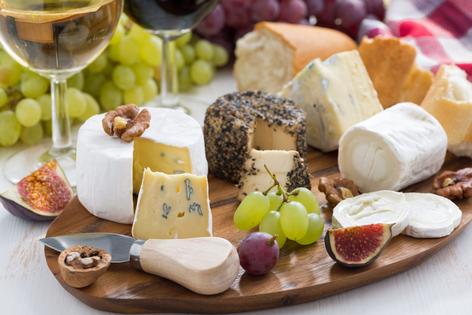Seriously Simple: Easy entertaining? It's all about the cheese course
There are many of us who love to include a cheese course when entertaining. I love it because it is fun to put together and requires no cooking.
Sometimes the occasion calls for a platter of elegant cheeses, condiments, good bread and a glass of wine to begin a meal. Other times, ending a meal with a fruit and cheese course is just the thing. Best of all, cheese courses are the essence of Seriously Simple; they are elegant flavorful and easy to assemble. They are also a clever solution for casual get-togethers like viewing the Super Bowl or the many award shows.
You'll want to choose three or four different cheeses with a variety of textures, such as soft, semisoft and firm. Pair the cheeses with sliced bread, crackers, fresh fruit and high-end condiments or nuts, depending upon the course served. Remove the cheeses from the refrigerator at least 30 minutes before serving, keeping them wrapped. They should be eaten at slightly below room temperature.
Just before serving, arrange wedges of cheese on a large wooden tray, flat wicker basket or flat ceramic platter, grouping the fruits, nuts, breads or condiments around the cheeses. Lemon leaves are pretty on the platter. To prepare the platter ahead, cover just the cheeses with plastic wrap or a damp kitchen towel, and add the accompaniments before serving.
Here are ideas for cheese courses to pair with wine, using the guidelines below for your wine selections. The starter course could be served before a meal or as an appetizer as guests are arriving. The last course offers suggestions for a dessert spread to serve after dinner, or even as a late-night course on its own.
Starter course
These are highly flavorful cheeses with nutty flavors. Look for goat cheese logs coated with herbs or seasonings. Add a country pate or slices of smoked salmon for a heartier platter. Some examples include:
Dry Jack
Chevre
Port du Salut or Morbier
Manchego
Gruyere or Comte
Fresh ricotta
Accompaniments: Apples (Fuji or Pink Lady, thinly sliced), figs, grapes (in clusters), a fresh baguette (sliced) and water crackers.
Condiments: olives, chutney, honey mustard.
Additions: smoked salmon, pates, prosciutto, sliced meats (like salami, mortadella or speck)
Dried fruit and nuts: dried pears, salted almonds, pecans or pistachios.
Dessert course
The colors and flavors of British cheeses -- such as sharp, nutty cheddars and smooth, blue-veined stiltons -- fit well with winter. Pair these with a creamy, mild Camembert or Brie and a triple cream cheese for a well-balanced platter. Small, local farms produce their own artisan cheeses, such as Maytag Blue or Point Reyes blue, so look for their counterparts in specialty shops with good cheese counters. Some examples include:
Blue stilton
Farmhouse cheddar
Camembert or Brie
Triple cream like St. Andre or Brillat-Savarin
Fresh ricotta
Accompaniments: Pears (Asian or red Bartlett, thinly sliced), Fuyu persimmons (peeled and thinly sliced), sliced melon, sliced nectarines or peaches, apricots (pitted and quartered), grapes (red or green, in small clusters), country bread (whole grain, sliced) and water crackers.
Condiments: fig compote, kumquat marmalade and white truffle honey.
Dried fruit and nuts: Spanish almonds, dried apricots, figs or dates.
Pairing wine and cheese
Here are some simple guidelines you can follow when planning your entertaining. Most cheeses can be grouped into one of five major categories. From there it's easy to select an accompanying wine. And if you are serving a variety of different cheeses, perhaps put out a couple of different varieties for your guests to enjoy.
Goat and sheep cheeses: Cheeses fit into this category when the tangy flavor of the milk predominates. Young goat milk cheeses cry out for a crisp young white such as sauvignon blanc, pinot gris, chenin blanc or French chablis. Harder, more mature cheeses such as pecorino have affinity for lively reds such as sangiovese or zinfandel.
Soft cheeses: The mouth-coating texture of soft cheeses can make red wines taste thin and tough. The effervescence of Champagne and sparkling wines cuts through beautifully. A crisp aromatic white (riesling, for instance) can also do well, especially if it has a bit of sweetness.
Hard cheeses: These cheeses match with a greater range of wines than those of any other category. Their firm consistency does not leave a trail of mouth-coating butterfat. Their deeper, more mature flavors can work well with powerful and complex reds, especially mature cabernet sauvignon, merlot, syrah, Italian barolo and Spanish Rioja, and even whites with some bottle age.
Blue cheeses: The moldy flavors of blue cheeses often fight with dry wines and can be tough on reds. Sweet wines such as Sauternes with roquefort or port with stilton are perfect partners. Late-harvest whites such chenin blanc, pinot gris, riesling, and semillon are usually a match made in heaven.
Extreme cheeses: Cheeses with bizarre and loud personalities include Epoisses, munster, and Limburger. Some of these cheeses are spiced or smoked. As fun as these cheeses can be, usually only sweet or fortified wines can hold their own against them. Consider a sweet sherry, Madeira, Sauternes, Hungarian Tokaji, or late-harvest gewurztraminer.
(Diane Rossen Worthington is an authority on new American cooking. She is the author of 18 cookbooks, including "Seriously Simple Parties," and a James Beard Award-winning radio show host. You can contact her at www.seriouslysimple.com.)







